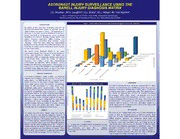
NASA Technical Reports Server (NTRS) 20150001881: Astronaut Injury Surveillance Using the Barell Injury Diagnosis Matrix PDF
Preview NASA Technical Reports Server (NTRS) 20150001881: Astronaut Injury Surveillance Using the Barell Injury Diagnosis Matrix
ASTRONAUT INJURY SURVEILLANCE USING THE BARELL INJURY DIAGNOSIS MATRIX J.D. Murray1, M.S. Laughlin2, D.L. Eudy3, M.L. Wear1, M. Van Baalen4 1Wyle, 1290 Hercules Drive, Houston, Texas 77058, [email protected], 2University of Houston, 3Enterprise Advisory Services, Inc., 4NASA Johnson Space Center Figure 1. Total number of astronaut injuries, Level II body regions by injury site, 2004-2013. INTRODUCTION Astronautsperformphysicallydemandingtasksandrisk incurring musculoskeletal injuries during both ground- basedtrainingandspacemissions. Theappearanceof increasedinjuryrateshasbeenattributedtonumerous factors, including an aging astronaut corps, increased Weightless Environment Training Facility (WETF) and Neutral Buoyancy Laboratory (NBL) training, and improved clinical operations that promote injury reporting. Over the years, NASA has implemented techniquestohelpdecreasethenumberofinjuries,but therehasnotbeenasystem-widesurveillanceprogram totrackinjuryrates. The Barell Injury Diagnosis Matrix is an injury classificationsystemthatmayserveasthefoundation of an injury surveillance system. The Matrix was introducedin2001asapotentialstandardizedmethod of classifying body region by nature of injury.1 Diagnoses are coded using the International Classification of Diseases, Ninth Revision, Clinical Modification(ICD-9-CM)codingsystem. Thepurposeof thisstudyistoassesstheusefulnessandcomplexityof theBarell Injury Diagnosis Matrixto classifyand track musculoskeletalinjuriesamongNASAastronauts. MATERIALS & METHODS A Certified Professional Coder through the American AcademyofProfessionalCodersreviewedtheICD-9-CM codes used in the 2005 Barell Injury Diagnosis Matrix update to ensure it contained a comprehensive set of LIMITATIONS injury codes and to verify the inclusion of diagnoses Figure 2. Number of Level II body injuries by year. unique to the environment of space travel. No TheEMRiscurrentlythebestsourceforastronautmedicaldata; additional codes were recommended. The Flight however,itseffectivenessasasurveillancesystemdatasourceis Medicine Clinic’s Electronic Medical Record (EMR) was limitedbyinaccuraciesofbothmedicaldataandICD-9-CMcodes queriedforallICD-9-CMcodescontainedintheMatrix. aswellasdelayswithdocumentapprovals. Theeffectivenessof Resultswerefilteredtoincludediagnosesfrom2004to the Matrix is hindered by its lack of Current Procedural 2013 for new medical events among NASA astronauts Terminology® (CPT) codes, which communicate information whowereactiveintheastronautcorpsatthetimeof about medical services and procedures received. Injuries may diagnosis. Injuries were categorized by body region bedocumentedbyICD-9-CMand/orCPTcodes,whichmayresult and nature of injury according to the Matrix. To inmissedcases. Furthermore,theMatrixgivesnoindicationof preventinflatingthetotalnumberofinjuries,multiple external cause or severity. This would give equal weight to a ICD-9-CM codes per person per body region in a simpleinjurysuchasanabrasionandamoresevereinjurysuch calendaryearwerecountedasasingleinjury. asanamputation,forexample. RESULTS CONCLUSIONS The Matrix classifies body regions using three levels. TheBarellInjuryDiagnosisMatrixmaybeasuitablecandidateon Level I: 36 small, well-defined categories; Level II: 9 which to base an astronaut injury surveillance system when mid-sizecategories;LevelIII:5broadcategories. Using there are no other viable options that use ICD-10 or SNOMED theLevelIIcategories,279injurieswereclassifiedinto coding systems. However, its limitations allow room for 7of9bodyregions. ‘SprainsandStrains’(40.5%)was improvement. TheMatrixislikelytounderestimatethenumber themostcommoninjurytype,and‘UpperExtremities’ REFERENCE of injuries, which may also differ from the number of injuries (30.8%) was the most common injury site. (Figure 1) 1."TheBarellInjuryDiagnosisMatrix,ClassificationbyBody reportedbyotherresearchprojects,becauseofdifferentinjury ‘System-wide&LateEffects’(9%)includeseventssuch RegionandNatureoftheInjury." CentersforDiseaseControl definitions and different approaches to identifying cases. This as motion sickness and toxic effects of venom. From and Prevention, 24 June 2010. Website: approach is intended to be a high-level summary capable of 2004 to 2013, the number of injuries per year ranged www.cdc.gov/nchs/injury/ice/barell_matrix.htm. Retrieved identifying trends over time. It does not take the place of from15to35withanaverageof27.9. (Figure2) 01Sept2014. individual research projects with their own injury definitions, specificanatomicalsites,andmechanismsofinjury. RwESwEARwCH. PPOoSTsERt PeRrESPENrTeATsIOeN DnEtSIaGNt ©i o201n2s.com
